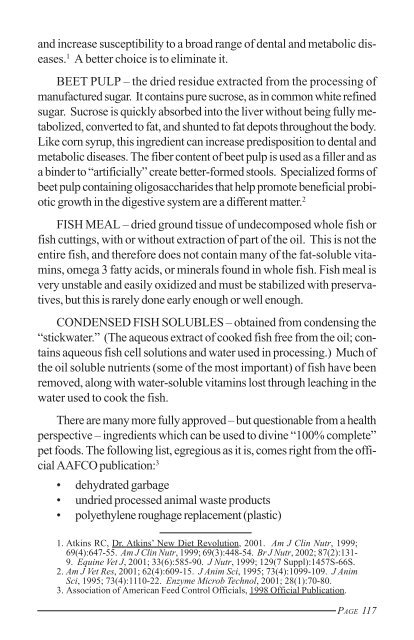The-Truth-About-Pet-Foods
The-Truth-About-Pet-Foods
The-Truth-About-Pet-Foods
Create successful ePaper yourself
Turn your PDF publications into a flip-book with our unique Google optimized e-Paper software.
and increase susceptibility to a broad range of dental and metabolic diseases.<br />
1 A better choice is to eliminate it.<br />
BEET PULP – the dried residue extracted from the processing of<br />
manufactured sugar. It contains pure sucrose, as in common white refined<br />
sugar. Sucrose is quickly absorbed into the liver without being fully metabolized,<br />
converted to fat, and shunted to fat depots throughout the body.<br />
Like corn syrup, this ingredient can increase predisposition to dental and<br />
metabolic diseases. <strong>The</strong> fiber content of beet pulp is used as a filler and as<br />
a binder to “artificially” create better-formed stools. Specialized forms of<br />
beet pulp containing oligosaccharides that help promote beneficial probiotic<br />
growth in the digestive system are a different matter. 2<br />
FISH MEAL – dried ground tissue of undecomposed whole fish or<br />
fish cuttings, with or without extraction of part of the oil. This is not the<br />
entire fish, and therefore does not contain many of the fat-soluble vitamins,<br />
omega 3 fatty acids, or minerals found in whole fish. Fish meal is<br />
very unstable and easily oxidized and must be stabilized with preservatives,<br />
but this is rarely done early enough or well enough.<br />
CONDENSED FISH SOLUBLES – obtained from condensing the<br />
“stickwater.” (<strong>The</strong> aqueous extract of cooked fish free from the oil; contains<br />
aqueous fish cell solutions and water used in processing.) Much of<br />
the oil soluble nutrients (some of the most important) of fish have been<br />
removed, along with water-soluble vitamins lost through leaching in the<br />
water used to cook the fish.<br />
<strong>The</strong>re are many more fully approved – but questionable from a health<br />
perspective – ingredients which can be used to divine “100% complete”<br />
pet foods. <strong>The</strong> following list, egregious as it is, comes right from the official<br />
AAFCO publication: 3<br />
• dehydrated garbage<br />
• undried processed animal waste products<br />
• polyethylene roughage replacement (plastic)<br />
1. Atkins RC, Dr. Atkins’ New Diet Revolution, 2001. Am J Clin Nutr, 1999;<br />
69(4):647-55. Am J Clin Nutr, 1999; 69(3):448-54. Br J Nutr, 2002; 87(2):131-<br />
9. Equine Vet J, 2001; 33(6):585-90. J Nutr, 1999; 129(7 Suppl):1457S-66S.<br />
2. Am J Vet Res, 2001; 62(4):609-15. J Anim Sci, 1995; 73(4):1099-109. J Anim<br />
Sci, 1995; 73(4):1110-22. Enzyme Microb Technol, 2001; 28(1):70-80.<br />
3. Association of American Feed Control Officials, 1998 Official Publication.<br />
PAGE 117


